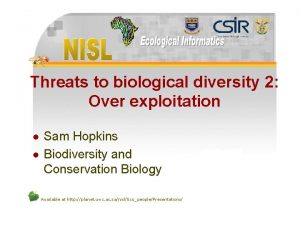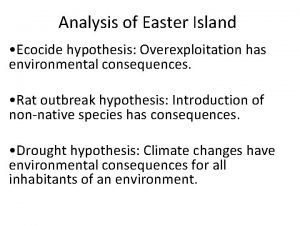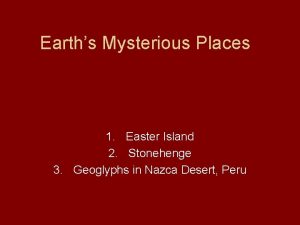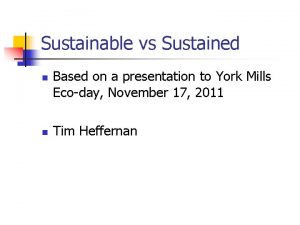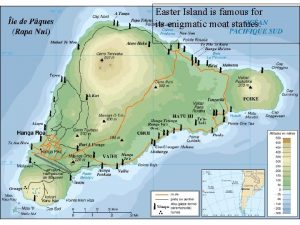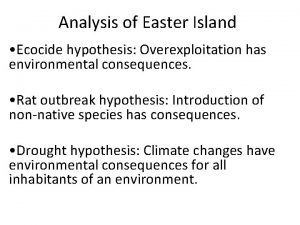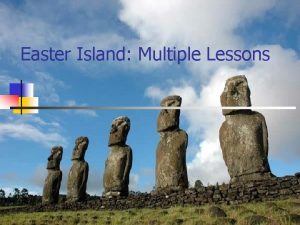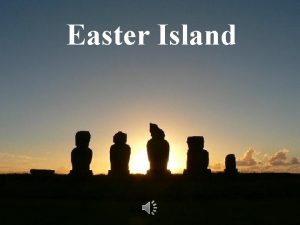Analysis of Easter Island Ecocide hypothesis Overexploitation has







- Slides: 7

Analysis of Easter Island • Ecocide hypothesis: Overexploitation has environmental consequences. • Rat outbreak hypothesis: Introduction of non-native species has consequences. • Drought hypothesis: Climate changes have environmental consequences for all inhabitants of an environment.

For the ecocide hypothesis to be correct, which of the following had to be true? • What signs of deforestation are there after the arrival of the first humans on the Island? • • What conclusion can be drawn from the rat outbreak hypothesis for Easter Island? • • The introduction of non-native species has environmental consequences. • • Which of the following societal decisions might result from the ecocide hypothesis about Easter Island? • • What policies and practices were put into place to manage resources wisely once ecological damage was done? • • What common factor was involved in all of the hypotheses to explain the collapse of Easter Island society?

How might the making of moai have led to the collapse of the forests on Easter Island? • The islanders cut down trees to transport the moai. • How were they transported? https: //youtu. be/J 5 YR 0 uq. PAI 8

Rat outbreak hypothesis: Introduction of non-native species has consequences. • Alternative – Many archaeologists have observed that the shells of palm tree seeds in cores and excavations show teeth marks from rats. • Hunt suggested that the rats introduced to the island would have had no natural predators. • The rat population would have grown and fed on the seeds of the palm trees. • This idea was consistent with findings on other Polynesian islands. Eventually, the tree population would have declined due to the rats as well as human activity. • Hunt based his hypothesis for the deforestation of Easter Island on the "rat outbreak. " https: //youtu. be/MFtw. Y 1 E 0 cq. Q

Climate Change hypothesis: . • Although Hunt's rat outbreak hypothesis was not widely accepted, it remains a viable explanation for the events of Easter Island. • In 2008, Daniel Man began examining core samples from Easter Island for evidence of climate change, particularly droughts. • He examined core samples and dated pollen samples and charcoal within them. These dates correlated with the sediments and soil erosion dates. • He concluded that a drought had just ended at about A. D. 1200 when he said the Polynesians arrived on Easter Island. He correlated evidence of burning with soil erosion and changes in weather patterns in the Pacific Ocean. • He concluded that drought, changing weather patterns, and human activities led to deforestation and subsequent soil erosion. These events precipitated the collapse of the Easter Island society.

In Your Own Time watch this video The Hidden Secret of the Statues on Easter Island • • • This HD video documentary reveals how Easter Island's Moai statues were constructed by experimenting with ancient engineering methods and mysterious traditions, modern archaeological scientists and engineers try and recreate and decipher their secrets. The statues are carved stone human figures with over-sized heads, often resting on massive rock platforms called ahus buried underground. There are 1, 000 statues that exist on the island, 30 feet tall, weighing a colossal 75 tons and are scattered about the barren landscape, in the mountains and close to the ocean. Society and tradition was tribal and a primitive culture, with black magic religious priests, chieftains writing strange hieroglyphic writing languages known as rongo. Yet this culture built monolithic statues not unlike Europe's Stonehenge. Without modern equipment, how were they built and moved? https: //youtu. be/m. H 0 s. Ij. AHBVY

Topic: “Lessons from History” Submission date: 8 September by 12: 00 Prepare a TYPED essay of no more than 2000 words summarising arguments and counter arguments that either A) The Rapanuians caused a pre-colonial ecological collapse through and monument building obsession (Diamond’s Ecocide Hypothesis) B) OR B) The Rapanuians were successful at adapting to a fragile and changing environment. You need to review the following material for assignment 1 (loaded at http: //planet. uwc. ac. za/nisl/ESS_2017/ESS 112/) • Jared Diamond’s Book Collapse: Chapter 2 Twilight at Easter • Terry Hunt and Carl Lipo Ecological Catastrophe and Collapse: The Myth of 'Ecocide' on Rapa Nui (Easter Island) • Terry Hunt and Carl Lipo Revisiting Rapa Nui (Easter Island) ‘‘Ecocide’’
